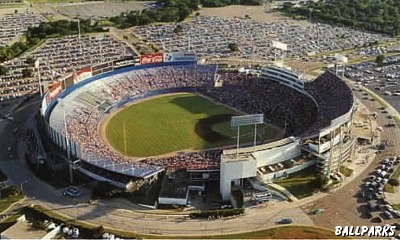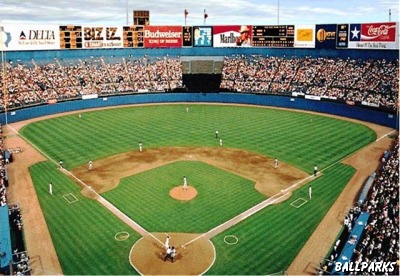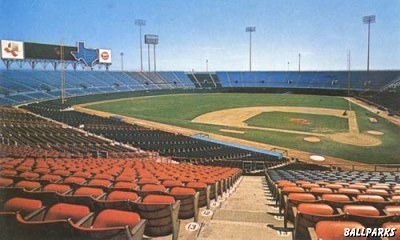Arlington Stadium
Arlington, Texas
Tenant: Texas Rangers (AL)
Opened: 1965
First Rangers game: April 21, 1972
Last game: October 3, 1993
Demolished: 1994
Surface: Tifway 419 Bermuda grass
Capacity: 10,500 (1965); 35,185 (1972); 41,097 (1979); 43,521(1992)
Architect: n/a
Builder: n/a
Owner: City of Arlington
Cost: $1.9 million (1965); $19 million for subsequent expansions
Texas Rangers tickets:
Location: Adjacent to Six Flags over Texas on the west side of the amusement park in the center of a parking lot bound by Stadium Drive E (E), E Randol Mill Road (S), Pennant Drive (W) and Copeland Road and I-30 (N).
Dimensions: Foul lines: 330; power alleys: 380 (1972), 370 (1974), 383 (1981), 380 (1982); center field: 400; backstop: 60 foul territory: small.
Fences: 11 (1972); 12 (1981); 11 (1986).
Arlington Stadium evolved out of a plan to build a ballpark for use by both Dallas and Fort Worth. Originally named Turnpike Stadium, it was built in the centrally located suburb of Arlington. Because it was built in a natural bowl, with a playing surface 40 feet below the surrounding territory, the stadium's $1.5 million price tag was estimated to have been one-tenth the cost of builing a similar facility elsewhere. Used as a minor league ballpark for its first seven years, the first Opening Day in the stadium was delayed as long as possible to allow workmen to put on the finishing touches. The last piece of sod was not layed until just 36 hours before the first pitch. Painting of the foul lines took place during the opening night pregame practice.
The stadium was expanded for the first time in 1970 to seat 20,000. When the Washington Senators announced they were moving to Texas, the park was renamed Arlington Stadium (because locals felt that Turnpike Stadium was inappropriate for a major league park) and was enlarged to a 35,694 capacity. Later expansions raised the capacity to its final level of 43,521. After the 1993 season, Rangers moved to the assymetrical Ballpark in Arlington (later renamed Ameriquest Field), built across the parking lot from Arlington Stadium, which was demolished in 1994.
Trivia:
- A.K.A. Turnpike Stadium (1965-1971).
- A huge Texas-shaped scoreboard stood behind the bleachers in left center until 1983, when it was replace by a Diamond Vision scorebaord.
- The bleachers were the largest in the majors, spanning the entire outfield, from foul pole to foul pole.
- Like Dodger Stadium and the Roman Colosseum, the field is located below the surrounding parking lots. Before the upper deck was added in 1978, fans would walk in at the very top of the stadium.
- Although the wind usually blew in the direction from the outfield, the ball carried well because of the heat.
- Because this was at one time the hottest park in the Majors, with temperatures regularly soaring into the 100s, almost all games (even Sunday games) were scheduled at night.
- This park had the most advertising of any Major League ballpark during its time.
- The seventh-inning stretch featured the song "Cotton Eye Joe" for the fans to dance to instead of the traditional "Take Me Out to the Ballgame."
- Was the birthplace of Dot Racing and ballpark nachos.
More on Arlington Stadium:
Recommended Reading (bibliography):
- Take Me Out to the Ballpark: An Illustrated Tour of Baseball Parks Past and Present by Josh Leventhal and Jessica Macmurray.
- The Ballpark Book: A Journey Through the Fields of Baseball Magic (Revised Edition) by Ron Smith and Kevin Belford.
- City Baseball Magic: Plain Talk and Uncommon Sense about Cities and Baseball Parks by Philip Bess.
- Diamonds: The Evolution of the Ballpark by Michael Gershman.
- Green Cathedrals: The Ultimate Celebration of All 273 Major League and Negro League Ballparks by Philip J. Lowry.
- Lost Ballparks: A Celebration of Baseball's Legendary Fields by Lawrence S. Ritter.
- Roadside Baseball: A Guide to Baseball Shrines Across America by Chris Epting.
- The Story of America's Classic Ballparks (VHS).
Help us provide a better web site by completing our feedback form
IMAGES:
Aerial view of Arlington Stadium by Munsey & Suppes.
Interior view of Arlington Stadium by Munsey & Suppes.
Early interior view of Arlington Stadium by Munsey & Suppes.
Updated April 2005
Tickets to NCAA Basketball Tournament, College Football Bowl, NCAA Football, Paul McCartney and Texas Rangers provided by Ticket Triangle.
BALLPARKS © 1996-2014 by Munsey & Suppes.
|







